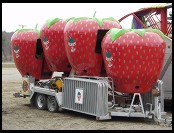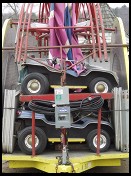

The world of digital cameras splits into two hemispheres. In the Southern Hemisphere there are point and shoots. These take forever to power up, a lifetime to focus, and a few decades between photographs. You can't see much through the viewfinder. You can't evaluate focus through the viewfinder because the viewfinder isn't through-the-lens. In the Northern Hemisphere there are single-lens reflexes (SLRs). The best of these work like film SLRs. Flip the on switch, evaluate your composition, focus, and settings through the big viewfinder, and snap. Want a different perspective? Unmount Lens A and mount Lens B.
Olympus's E-20 can best be described as straddling the Equator between these worlds. In bulk, price, and performance the camera averages the capabilities of digital point and shoots and full professional digital SLR bodies. For a bit less than $2000 you get a self-contained 5-megapixel single lens reflex body permanently attached to a 9-36mm/2.0-2.4 zoom lens (equivalent perspective to a 35-140mm lens on a 35mm camera). The camera produces 8-bit JPEGs or 10-bit RAW-format images 2560x1920 pixels in size.
If you're familiar with the Olympus E-10, the E-20 is basically the same camera with higher resolution, shorter processing delays, and some other minor improvements. In fact, so similar is the camera that the reader should see the review of the E-10 for many details of operation.
We still love the idea of the Olympus E-series: a real viewfinder, an ergonomic body, a lens whose coverage matches the size of the imaging sensor. But the reality of the E-20 is less than impressive, particularly considering how little improved it is over the E-10.
The E-20 has the body of a professional single-lens reflex camera but the CPU soul of a cheap point-and-shoot. It is slow (6 seconds) to turn on. It is slow in between shots. It is slow when writing images to the flash card.
It isn't possible to hold a picture on the rear LCD screen by holding down the shutter release, as with Canon products. You have to switch the camera into the dreaded playback mode, in which it becomes useless as a camera and cannot take any pictures, or press a button on the rear of the camera twice. The E-10 takes several seconds to bring up the image on the LCD.

The E-20 should be a good companion in low light, despite its maximum sensitivity of ISO 320. The lens is a fast 2.0. Most of the controls are individual buttons and knobs that can be operated by feel. The built-in flash is powerful and pops up a reasonable distance from the lens for red-eye avoidance. The camera offers active infrared autofocus (it sends out a beam), film SLR-style contrast maximizing passive autofocus, and manual focus. For the E-20, Olympus has also added a long-exposure averaging system to reduce noise in the shadows.

A camera at this price really ought to be bundled with a lightweight version of Adobe Photoshop. But it isn't. Olympus gives you a plug-in for Photoshop that will let you process and manipulate the 10-bit RAW images from the camera.
All digital cameras ought to be bundled with high quality image library management tools. But the Olympus E-20 is not.
Where camera companies fail, Microsoft comes through. If you plug the E-20's USB cable into a Windows XP machine, XP recognizes the device as a camera and asks "Would you like to copy these images to the hard drive". Once you've copied the images (8-bit JPEGs only) over, the native Microsoft operating system file explorer can show you thumbnails, rotate images clockwise or counterclockwise (the E-20 is too dumb to know whether it was being held horizontally or vertically and hence does not encode vertically captured JPEGs corrected).

On its face, the E-20 is a poor value. For half the price and less than half the size you can get a point and shoot from Canon or Nikon that affords similar image quality and processing delays. For a bit more money you can get a 6-megapixel digital single lens reflex with interchangeable lenses, e.g., Fuji S2, Nikon D100, Canon D60, or Sigma SD9.
My personal theory is that the Olympus E-20 will appeal to middle-aged people who are accustomed to the high-quality viewfinder and logical controls of a manual film single-lens reflex. A person whose last camera was a Nikon FE or Minolta SRT-102 is never going to understand how anyone can create a good image with a point-and-shoot digital camera. At the same time such a person might not want to adopt the bulk and complexity of a full-size digital SLR. Nor might that person want to lug around unnecessarily large lenses that cover a larger image area than the digital sensor.
Text and photos copyright 2001 Philip Greenspun.